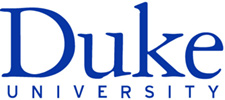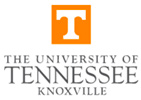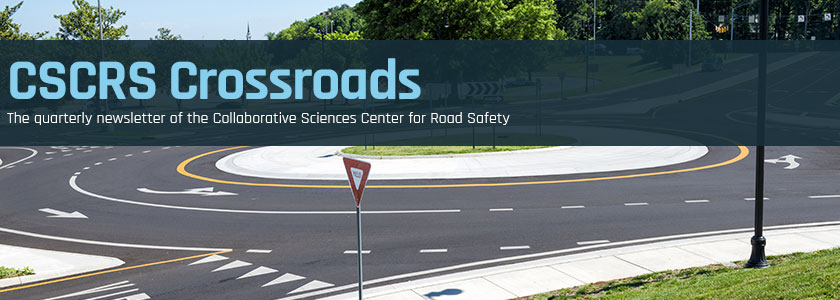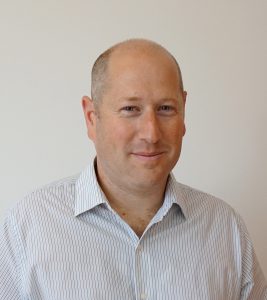Introducing CSCRS Crossroads
We are pleased to release the first issue of the Collaborative Sciences Center for Road Safety newsletter, CSCRS Crossroads, which reports on activities and news surrounding CSCRS’s cross-disciplinary research, education and professional development endeavors. This quarterly newsletter will keep CSCRS stakeholders like you informed of current and upcoming research and educational activities.
CSCRS hit the ground running when its U.S. Department of Transportation University Transportation Center award was announced in December 2016. This newsletter explores our accomplishments to date including forming an advisory board, announcing new research projects and spreading the news about CSCRS at transportation safety-related events. It also includes an interview with CSCRS Associate Director Dr. Offer Grembek of the University of California, Berkeley; interviews with key team members will be regular features of upcoming issues of CSCRS Crossroads.
A major goal of CSCRS is to expand beyond traditional “transportation audiences,” and that desire extends to the distribution of our newsletter. Please share this new resource with colleagues, peers and friends in the fields of engineering, public health, computer science, planning, robotics and data science. If you received this newsletter because someone forwarded it to you, please subscribe here.
What is a University Transportation Center?
The U.S. Department of Transportation launched the University Transportation Center Program in 1988 under the direction of the Surface Transportation and Uniform Relocation Assistance Act of 1987. At that time, US DOT awarded grants for UTCs in the standard Federal regions with the purpose of promoting research.

According to the US DOT website, “DOT invests in the future of transportation through its UTC Program, which awards and administers grants to consortia of colleges and universities across the United States. The UTC Program advances the state-of-the-art in transportation research and technology, and develops the next generation of transportation professionals.”
Since 1988, the program has been reauthorized every few years into different iterations. The UTCs announced in December 2016, including CSCRS, were authorized by the Fixing America’s Surface Transportation Act, which was signed into law in December 2015 and specified six research priorities for UTCs: improving mobility; reducing congestion; promoting safety; improving transportation infrastructure; preserving the environment; and preserving the existing transportation system.
In a December 2016 statement about the newly awarded UTCs, then U.S. Transportation Secretary Anthony Foxx explained, “Our nation faces unprecedented challenges from population growth, a changing climate, and increasing freight volumes. Universities are at the forefront of identifying solutions, researching critical emerging issues, and ensuring improved access to opportunity for all Americans.”
To learn more about the history of the UTC program, visit here.
Building a winning team: CSCRS Advisory Board and Executive Committee
CSCRS is led by an impressive team of industry thought leaders, university researchers and seasoned professionals to assist in both honing our strategic direction and managing every day work and activities.
Advisory Board
The Advisory Board offers executive-level guidance and big picture input on the CSCRS vision and priorities. Thank you to those who have agreed to serve as founding members of the CSCRS Advisory Board including:
- Linda Bailey, executive director, National Association of City Transportation Officials;
- Ann Dellinger, branch chief, Home, Recreation, and Transportation Branch, Centers for Disease Control and Prevention’s National Center for Injury Prevention and Control;
- Dia Gainor, executive director, National Association of State EMS Officials;
- Chuck Gulash, director, Toyota Collaborative Safety Research Center;
- Jeff Paniati, CEO and executive director, Institute of Transportation Engineers;
- Heather Rothenberg, lead, Trust and Safety Research, Uber
- Leah Shahum, director, Vision Zero Network;
- Bryant Walker Smith, assistant professor, School of Law, University of South Carolina; and
- David Yang, executive director, AAA Foundation for Traffic Safety.
The Advisory Board will hold its first meeting in summer 2017 to discuss priorities for the Center.
Executive Committee
The CSCRS Executive Committee unites leading transportation research, planning, public health, data science and engineering programs and personnel from each of our consortium member university campuses. David Harkey, UNC Highway Safety Research Center, leads CSCRS as Center director, and the CSCRS associate director team is comprised of:
- Michael Clamann, Humans and Autonomy Lab, Pratt School of Engineering, Duke University;
- Eric Dumbaugh, School of Urban & Regional Planning, Florida Atlantic University;
- Offer Grembek, Safe Transportation Research & Education Center, University of California, Berkeley;
- Asad Khattak, Civil & Environmental Engineering Department, University of Tennessee, Knoxville;
- Stephen Marshall, UNC Injury Prevention Research Center, University of North Carolina, Chapel Hill; and
- Noreen McDonald, Department of City & Regional Planning, University of North Carolina, Chapel Hill.


![]()


Additional CSCRS key personnel include Laura Sandt, research programs manager, and Caroline Mozingo, education & outreach programs manager, both of the UNC Highway Safety Research Center.
For more about the CSCRS team, visit www.roadsafety.unc.edu/about/team.
CSCRS research underway with first eight projects
In March, CSCRS announced eight research grant awards for 2017. CSCRS selected the research proposals from across the Center’s five consortium campuses. These first eight “quick start” projects were proposed, selected and initiated within three months of the University of North Carolina, Chapel Hill receiving the National University Transportation Center grant in December 2016. Projects awarded cover topics that closely fit within the Center’s goals and provide opportunities to engage staff and professionals working in several disciplines including public health, engineering, planning, data science and robotics.
The selected projects include:
- “A Comprehensive System to Support Parents of New Teen Drivers” (led by Arthur Goodwin, University of North Carolina, Chapel Hill);
- “Advanced Analytics for Vulnerable Road User Scenarios” (led by Noreen McDonald, University of North Carolina, Chapel Hill);
- “An Enhanced Systemic Approach to Safety” (led by Offer Grembek, University of California, Berkeley);
- “Completing the Picture of Traffic Injuries: Understanding Data Needs and Opportunities for Road Safety” (led by Chris Cherry, University of Tennessee, Knoxville);
- “Development and Evaluation of Vehicle to Pedestrian (V2P) Safety Interventions” (led by Michael Clamann and Missy Cummings, Duke University);
- “Identifying the Safety Information Needs of Major Cities in the United States” (led by Eric Dumbaugh, Florida Atlantic University);
- “Safe Systems Synthesis & Summit Phase 1” (led by Eric Dumbaugh, Florida Atlantic University); and
- “Structures of Stakeholder Relationships in Making Road Safety Decisions” (led by Seth LaJeunesse and Steve Marshall, University of North Carolina, Chapel Hill).
For more on these initial CSCRS research projects, visit www.roadsafety.unc.edu/research.
CSCRS on the go
CSCRS is already part of the conversation at in-person transportation events, and we will continue to attend relevant conferences and meetings to forge connections with transportation, public health, computer science and other peers. The following are road safety events that CSCRS staff recently attended and will attend over the next several months:
Lifesavers
March 26-28, 2017
Charlotte, N.C.
Summit of University Transportation Centers for Safety
April 6, 2017
Washington, D.C.
2017 CUTC Annual Summer Meeting
June 19-21, 2017
Buffalo, N.Y.
Automated Vehicles Symposium
July 11-13, 2017
San Francisco, Calif.
5th Annual UTC Conference
November 16-17, 2017
Gainesville, Fla.
Join CSCRS on social media
Like our Facebook page and follow us on Twitter.
Sign up to receive CSCRS news and updates.
CSCRS Crossroads newsletters are archived here.






